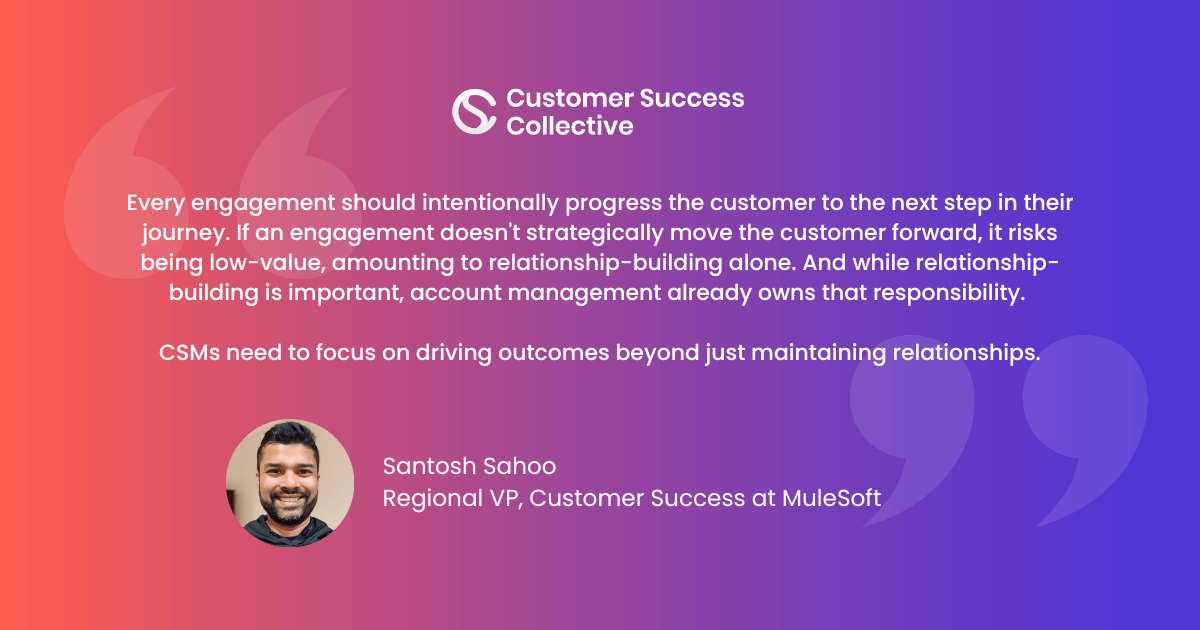When it comes to discussing customer success (CS), especially in the realm of SaaS, the concepts of "high touch" and "scale" rarely coincide in the same sentence. Until now.
A conversation around these two seemingly distinct topics is desperately needed.
When we talk about high-touch customer success, we traditionally infer a meticulous “white-glove” level of service. Ordinarily, this is diametrically opposed to concepts of scaling, which tends to lean heavily into digitization and broad, automated outreach.
But as we charter the unpredictable waters of SaaS, the interplay of these two elements has been immensely valuable.
Let’s explore the journey through various facets of customer success, understanding its complexities, challenges, and the innovative strategies employed to harness optimal customer engagement and satisfaction.
In this article, I’m going to cover:
- Balancing new and existing clients
- Optimizing financials while growing your customer base
- Redefining engagement and ensuring value
- Designing engagements that drive real business value
- Aligning with sales and selecting the right customers
- Specializing skills to boost customer success outcomes
- Scaling with standardization and automation
- Blending personalized service with digital self-service
- Merging reactive and proactive approaches
- Reimagining customer success through P&L management
- Turning customer success into a revenue generator
- Building intentional, high-value customer success programs
- Why securing leadership buy-in is critical
Let's get started.
Balancing new and existing clients
Something I’ve noticed about certain SaaS companies that are flourishing is a notable decline in new-logo acquisitions.
Their financial solvency has often been maintained through a trusted, continual revenue stream from their existing clients, rather than through the acquisition of new ones. This recurring theme prevalent amongst large SaaS companies propels them to significant results.
Moreover, it’s a universal motion: whether your path is product-led growth (PLG) or customer-led, a pattern emerges as a company scales.
Typically, about 75% to 80% of revenue is generated from a mere 20% of the customer base, particularly from large enterprise clients.
Despite a long tail of customer acquisition and potential for expansion, it’s vital to acknowledge the inordinate impact of that core 20%, especially in the contemporary market that leans heavily into customer-led growth.
Optimizing financials while growing your customer base
A third pivotal point revolves around customer acquisition, scrutinizing the ratio between customer success metrics like customer lifetime value (LTV) and customer acquisition cost (CAC), as well as a sharp focus on maintaining margins.
As companies tighten budgets and can't expand customer success teams as fast as they add major logos, the burden falls on existing CS teams to find a workable compromise.
The challenge lies in maintaining a similar level of high-touch, white-glove service and high-level engagement without proportionally escalating the CS team size or altering the ratio between accounts and Customer Success Managers (CSMs).
This is not a hypothetical scenario; it mirrors Mulesoft’s own journey as we approach a valuation of $2 billion. The initial model that we, and perhaps many scaled organizations, employed entailed a high-touch model with tiered structures: Directors of Customer Success managing a select few accounts and CSMs handling between 30 to 50 accounts.
However, a poignant realization dawned upon us: we were veering away from the true north of our mission. Our mission was to genuinely engage customers and deliver impactful outcomes daily, without necessarily expanding CSMs in direct correlation with closed logos.
Redefining engagement and ensuring value
In reflection, we paused, reassessing our trajectory and redefining our objectives. The conclusion was succinct yet profound: our aim is to deliver high-value engagements to the right customers, at the opportune time, while meticulously managing the profit and loss statement (P&L).
This last point, the integration of managing a P&L, has increasingly permeated CS leadership dialogues and boardroom discussions. A shift from merely focusing on renewals to exploring expansion, whilst managing a P&L, is not merely a trend, but rather an emerging staple in the boardroom narrative.
Blending high-touch customer success with scalable strategies is not only possible but pivotal, especially in the current market landscape.
While challenges persist, embracing this duality, and exploring innovative solutions that ensure customer engagement and operational efficiency, is imperative for sustaining and accelerating growth in the contemporary SaaS space.
Designing engagements that drive real business value
A poignant realization emerged as we scrutinized the typical interactions in the high-touch model, especially considering the cadence calls within CSM.
I’m sure you’ll relate to this:
When CSMs schedule their weekly client calls, only about half actually end up speaking with the intended customer contact. The other calls either get canceled or attended by different stakeholders who may not be the most relevant contact to the task at hand.
A question thus forms: How many of these engagements, often long and undulating, actually drive outcomes or present genuine, high value?
Our initial strategy encompassed about 24 such engagements that a CSM would execute.
A paradigm shift occurred when we scaled this down to a succinct six to eight engagements, meticulously designed to be productized and purposeful rather than mere conversations.
This approach ensured that every engagement was defined, teams were aligned, engagements were delivered effectively, and subsequent engagements were systematically planned.
Not only did this streamline our CSM team, making them more focused and expertise-driven, but it also garnered a clear commitment from the customers, choosing to actively engage and ascend towards betterment.
Aligning with sales and selecting the right customers
Importantly, aligning well with sales became a pivotal aspect, particularly regarding focusing on specific customers and engagements.
We carefully put our resources where the sales team wanted to focus, instead of spreading Customer Success Managers (CSMs) evenly across all accounts. To be clear, we aren’t talking about all customer accounts, but specifically adjusting our approach within the named CSM model size, while maintaining a digital scale model for a set of accounts.
When considering the "right" customer, we prioritized those who exhibited a willingness to engage and progress. Establishing engagements that reciprocally partnered with customers, aiding in mutual progress, proved invaluable.
Specializing skills to boost customer success outcomes
Skill refinement emerged as another cornerstone, allowing CSMs to specialize, for instance, in areas like value realization where their strengths naturally lay.
Unlike in the past, where individuals might be tethered to specific account sets, this new flexibility allowed us to deploy experts within CS teams for specific, high-value engagements. This enabled not just an elevation of customer interaction but also a means through which team members could harness and apply their specific skills optimally.
Scaling with standardization and automation
Scaling became not just viable but more robust and streamlined through standardizing a list of engagements in this high-touch model. We incorporated Slack to automate numerous workflows, particularly in reactive engagements and pivoted towards prioritization using insightful data.
By weaving together high-value engagements, precise alignment with sales, skill refinement, and scalability through automation, we've begun to intricately blend the high-touch model with scalable strategies.
Blending personalized service with digital self-service
As we dive further into our journey of CS, the role of our digital offerings comes into sharper focus.
These offerings significantly enhanced our customer’s access to our sprawling digital ecosystem.
It's a subtle, yet vital dance: delivering precise, CSM-focused engagements atop the stable platform of our digital services. The integration and balance of digitized and humanized approaches informed our interactions and strategies for fostering customer success. But how did we choose the “right” customers, and moreover, ensure our engagements were deployed judiciously?
Initially, around 50-55% of our customers were all named. We refined this to focus on a smaller, high-value cohort (approximately 10%) while maintaining the named CSM model. The remaining 40% shifted to our engagement model, which has now been in action for almost two quarters.
Preliminary data surrounding this new approach is starting to emerge, painting an intriguing picture of its efficacy and impact. Alongside this, our long-tail customers continued to be serviced efficiently through our digital scale model, which has been robustly established for about a year.
This approach afforded us an admirable flexibility in motion and strategy. For instance, smaller customers, demonstrating vast potential, could have a dedicated engagement carved out for them.
Simultaneously, if strategic customers showed altered growth potential or began to trade differently, tier adjustments were possible, ensuring resources and efforts were proportionately and effectively distributed.
This nuanced strategy allowed us to optimize our customer interactions and value delivery, even amidst common challenges like frozen headcounts, by maximizing the efficacy and impact of each engagement under this model.

Merging reactive and proactive approaches
Let’s venture into the concept of the “right time,” an amalgamation of reactive and proactive engagements.
The reactive engagement is relatively straightforward: a customer requests a specific engagement, like an architectural review, or perhaps the sales team identifies a need for a particular interaction – these are directly responsive.
Conversely, the proactive approach is rooted in strategic foresight and data utilization. Leaders like us, armed with a wealth of customer adoption data and health data, are empowered to orchestrate engagements even before a customer signals a need.
If I, for example, observe that 15 customers exhibit low adoption and pose a risk of churn, I can create an engagement for the CSM to proactively connect and address potential issues before they burgeon into tangible problems.
Contrary to some perceptions that this model is predominantly reactive – a “when the customer calls, we answer” approach – our experience demonstrates a 70:30 split in favor of proactive engagements.
And remarkably, this is achieved by utilizing the same team. The engagements aren’t simply conversations; they are outcome-driven, producing tangible outputs and results, contrasting with the sole use of a CSM under a named model.

Reimagining customer success through P&L management
As we wrap up this discussion, I want to highlight the importance of managing customer success through a profit and loss lens. Rather than just executing, we should think about productizing the customer success motion - specifically looking for opportunities where customers are willing to pay.
Through our research, we discovered a willingness from some of our largest customers to compensate us when we properly productize the service.
For example, roles like Technical Account Managers, who interface with support and provide architectural guidance, or Premier Support plans with greatly reduced SLAs for mission-critical products, are services they are ready to invest in.
Additionally, if we offer advanced monitoring features or implementation architects, we'll likely find budget allocated for those as well.
Turning customer success into a revenue generator
Customer success, traditionally seen as a cost center, is starting to transform into a profit driver. By managing their own P&L, customer success teams have the potential to ultimately become self-funding over time.
Though still a relatively new idea, many large organizations are shifting towards having their customer success teams operate their own P&L statements. This elevates customer success to have equal standing with sales, essentially turning it into a revenue-generating function.
This aligns well with my core belief:
"High-value engagements, ideal customers, optimal timing, and P&L management."
While our high-touch model scaled well up to $1.75BN in revenue, it's no longer sustainable due to the need to proportionally add more staff as our customer base expands. This is especially true as customers require increasing levels of support from customer success when dealing with complex platforms

Building intentional, high-value customer success programs

We've realized that future CS programs need to be intentional, harboring intrinsic high value and engagement, rather than being a compilation of cadence calls.
Over the next five years, the industry trajectory suggests CS leaders will increasingly be tasked with generating revenue plays from their teams. Thus, our experiments in this realm begin.
Engagements should be more than relationship-builders – they need to be outcome-driven.
Every engagement should intentionally progress the customer to the next step in their journey. If an engagement doesn't strategically move the customer forward, it runs the risk of being non-valuable, amounting to mere relationship-building, which, while significant, is already being covered by an account team.
It's not solely the purview of the CSM to maintain relationships. Instead, CSMs need to focus on driving outcomes.
Why securing leadership buy-in is critical
When we made this transformative change, the biggest challenge was not pushback from customers, but rather managing the change internally.
It was critical to give every internal stakeholder a clear new role and piece of the puzzle. Surprisingly, customers, who just need a point of contact and value-driven engagements, were quite open to the shifts.
For those considering a similar model, the key advice is to secure full buy-in from top leadership. With pressures on margins and management objectives, having your leadership fully aligned with this approach is essential to not just make it viable, but ensure smooth execution.
Customer success has an enormous impact across an entire organization, but it's a relatively new strategy. It's for this reason that it's crucial to overcome internal skepticism.
With the leadership team actively championing the changes, it becomes possible to implement them in harmony with business goals and overcome any internal resistance. Their full support makes the difference between success and struggle.
Looking for more game-changing customer success insights?
Don't just read about it – live it yourself at an upcoming Customer Success Festival near you!
Imagine spending a full day immersed in the latest innovations, radical new frameworks, and proven roadmaps for accelerating customer success. Picture rubbing shoulders and networking with the brightest minds while uncovering new ways to drive adoption, retention, expansion, and lifetime value.
You'll leave overflowing with actionable takeaways, innovative ideas, and powerful new connections to help you take your customer success programs to the next level.
This article is based on a presentation given by Santosh at the Customer Success Festival New York in March 2023.
Catch up on this presentation, and others, using our OnDemand service. For more exclusive content, visit your membership dashboard.
Life's too short for incremental improvements – it's time to transform.
Unlock your full potential by joining us at the next Customer Success Festival.



 Follow us on LinkedIn
Follow us on LinkedIn




